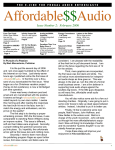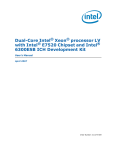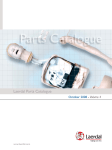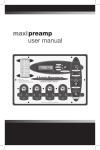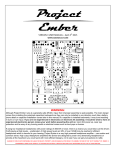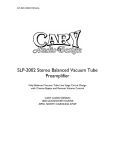Download DYNACO Stereo 70 Owner`s manual
Transcript
Dynaco Stereo 70 Repair Guide I. Introduction A. Tools Required - Before you begin you should have a few basic tools on hand to help you identify and repair the problem. Please obtain the items outlined in the following list: • RCA shorting plugs (Fabricate using Radio Shack # 274-339) • Digital Voltmeter (Inexpensive Model from radio Shack) • Soldering Iron & Associated items (See the CAE Soldering Tutorial Tech Note @ http://www.curcioaudio.com/sup_3.htm ) • Screw drivers, Pliers (including needle nose), wire cutters & stripper (See the CAE Recommended Tools Tech Note @ http://www.curcioaudio.com/sup_3.htm ) • Wire Jumpers with Alligator Clips (Radio Shack # 270-180) • 100 ohm 2 Watt resistor (not a critical value, any value near 100 ohms will be fine) • 20 fuses rated at 3 Amps, Slo-Blo (not larger nor smaller) • Documentation (schematic diagrams and parts list) for defective component – Note: You will find a full copy of the Dynaco Stereo 70 Owner’s manual at our website ( http://www.curcioaudio.com/dynadr_3.htm ) B. General Discussion In this document, I hope to provide you with some methods and techniques that will guide you to repair most any problem in your Stereo 70. However, it is absolutely critical that you are certain that you have the skills to safely operate the tools recommended and that you always remember that you will be working with lethal voltages. The electrolytic capacitors will continue to store and present even after you have removed the power and disconnected the line cord. Once again, always assume that lethal voltages are present and work accordingly. That means never place yourself in a position to be the conductor between the circuit and ground (let the jumper become the more direct current path). The most effective technique for the diagnosis of problems with your components is the Isolation & Elimination method. With this methodology, we will initially eliminate the functional components until we isolate the defective component, section, subsection and finally the part. For example, if you have hum in your system, it is important to determine if the hum is being generated inside your Stereo 70 or is being injected into the Stereo 70 from your preamp or from poor shielding or thru the power line, among other paths. Using the Isolation & Elimination methodology, we would first place RCA shorting plugs at the input to your Stereo 70. If the hum is still present, it is safe to eliminate everything but the power amplifier and associated components. Alternatively, if the hum is eliminated, you can safely conclude that the problem exists upstream of the power amplifier. In this case you would proceed to examine the components upstream. Reconnect your preamp to the Stereo 70. Remove all input sources from the input of the preamp. Select a line level input, such as the tuner input (with the preamp’s selector 1 switch) and place the RCA plug into the selected input. Apply power to both the amp and preamp. If the hum is present, the problem is near the preamp line stage. If the hum is not present, place the input shorting plugs into the preamp’s Phono Inputs and select the phono input with the preamp’s selector switch. Observe again - hum or no hum; phono is implicated or not. Once you have identified the problem component it is time to dig into that component and begin the I&E process again to zero in on the defective part or parts. Using the isolation & elimination technique, it is possible for you to identify and repair many problems within your entire system. However it is very important that you do not make assumptions and skip the top tier isolation steps. I have been doing this for many years and still continue to cause myself hours of wasted time by thinking that I already “know” which component is at fault. A huge benefit of working on two channel components is the ability to compare the operation and measurements of the “good” channel to the defective channel. The differences can be very informative in locating the defective part in the non-working channel. During the course of this discussion you will be asked to switch the tubes from channel to channel as an isolation technique. In general, if the problem moves with the part switch, the part is defective. However if the problem remains in the same channel, the part is probably OK and the fault lies in the circuitry associated with that channel. This also applies to voltage measurements - you can compare the readings from channel to channel to help you understand what is expected vs. what is defective. For you to repair and maintain the performance of your Stereo 70, it is very helpful for you to read and understand the three principal sections of your Stereo 70 and how they interact. The next section discusses each section briefly. II. Stereo 70 Overview : Tube power amplifiers are relatively simple devices and consist three main sections: 1) The Power Supply – The power supply consists of a. The line cord, b. Fuse & Fuse Holder c. Power switch, d. Power transformer, e. Rectifier (tube is stock, modified may be diodes) & Tube Socket f. Choke, g. Filter capacitor (the Quad electrolytic “can”), and h. Bias supply. The Bias supply consists of the rectifier diode (in the original it was a selenium “stack”), filter capacitors (2), fixed resistors (2), and bias pots (2, one for each channel). Because the power supply is common to both channels, symptoms that effect both channels (dead amp, fuse tripping, hum in both channels, weak power in both channels, etc.) is usually the result of a problem in the power supply. 2 2) The Output Stage – There are two output stages, one for each channel. Each output stage consists of : a. the output transformer, b. output tubes (2 per channel), and c. cathode bias resistor (the original value was 15.6 ohms and had the appearance of a white ceramic tubular device connected to pins 1 & 8 of both output tubes). d. The output tube sockets should also be considered a “component” in the output stage – they have a higher incidence of failure than the typical mechanical component due to the constant high temperature exposure. That’s it – really simple. It is important for you to know that the output stage tubes are meant to conduct a little “bias” current when the amp is idle. This bias current is controlled by placing a negative voltage at the control grid (pin 5 of the EL34 output tubes). Note - if this negative voltage were to disappear, the control grid will fall to zero volts and at this point the tubes will conduct way too much current causing the familiar glowing red plate elements (from the heat). Eventually the fuse will trip or, if too late, the tubes will be destroyed. The negative voltage needed to keep the tubes conducting the desired current is produced in the bias supply (located in the power supply section) and is delivered to the control grid (pin 5) via the tube socket. Therefore should the tube socket corrode or otherwise fail to connect to the tube control grid pin (5), the voltage appearing at the control grid (pin 5) will fall to zero causing the tube to conduct excessive (and destructive) current. You may want to think of the negative control grid voltage as the adjustable safety valve. Because each tube differs from unit to unit, it is necessary to make this voltage variable and user adjustable. This adjustment is made via the BIAS ADJUSTMENT pots (located on the amp between the rectifier tube and Quad filter capacitor). As the user adjusts the voltage on the control grid, the current flowing through the tube (from plate to cathode) flows into the Cathode Bias Resistor (the 15.6 ohm resistor discussed above) causing a voltage drop to appear across this resistor (via ohms law). The user then measures the voltage across the resistor as an indicator of the current flowing through the tube (via ohms law Voltage = Current X Resistance). Since the current flowing through each tube should be about 50mA, and since both tubes (in one channel) have their cathode current flowing through a single common Bias Resistor, the total current through the bias resistor will total 2X 50mA, or 100mA. By Ohms law, 100mA X 15.6 ohms = 1.56 Volts (DC) – and this is the Bias Voltage specified by Dynaco. Failures in the output section usually manifest themselves as bias difficulties (too much or too little) usually the result of problems in the bias supply, weak or shorted tubes, defective tube sockets (loose or corroded terminals), or (rarely) defective output transformers. 3) The Driver Amplifier & Phase Splitter – This is perhaps the most complex part of the Stereo 70 power amplifier. It is the 7” X 4 “ (approximate) PC board located in the front center of the amp between the two pairs of output tubes. It 3 houses two identical channels each consisting of a 7199 signal tube and associated resistors and signal capacitors. The 7199 contains two sections – the pentode section (where the input signal from your preamp is initially amplified), and a triode section where the signal is split into two equal, but out of phase signals (out of phase means that one signal is the mirror image of the other). For push pull amplifiers (like the Stereo 70) it is necessary to deliver two out of phase signals to the output section. Failures in the driver section usually manifest themselves as differences in channel level, distortion, buzzes, crackles, hissing, or other disharmonious sounds. Most often the problem appears in only in one channel. The signal from the driver board circuit is sent to each of the four output tubes (individually) via a coupling capacitor (0.1uF). Note that the voltage on the driver side of the coupling capacitor is at hundreds of volts (positive) and the voltage at the output tube side of the coupling capacitor is at the output tube control grid’s (pin 5) negative voltage. If the capacitor becomes only moderately leaky, current will flow into the bias circuit of the output stage and as a result it will be impossible to bias the output tube correctly. This is an uncommon failure however it is worth mentioning since it is in concert with our discussion in the output section. Frankly, the driver stage is one of the two sections of the Stereo 70 that was not designed with longevity in mind. The board material is phonelic (really pressed paper) that absorbs moisture and does not hold up well to the typical heat present inside the Stereo 70. The solder traces are very thin and the pads are small and combined with the inferior board material the adhesion is marginal. This makes the removal and replacement of components very difficult usually causing board damage. Therefore we strongly recommend replacing the driver section should the diagnosis point towards the driver board. In fact, it is recommended that the driver board be replaced irrespective of the analysis to dramatically improve reliability and performance. III. Troubleshooting A. Isolation & Elimination – e.g. Make Sure the Problem is in Your Stereo 70 Unless you have a single component that simply won’t power up, it will be necessary to isolate the component causing the problem. Accordingly, if your Stereo 70 fails to power up or trips its fuse, proceed to Section III-B below. Regardless if the problem is hum, hiss, or any other sonic defect, in the beginning your loudspeakers have been your only instrument telling you something is not right. To be sure that the problem is indeed within your Stereo 70, you will need to fabricate a pair of RCA shorting plugs. You will find in the future that they will become a very valuable diagnostic tool. RCA shorting plugs can be fabricated by connecting the inner (+) terminal to the outer (-) terminal of a standard male RCA plug. Take the time now to create a pair. They will help you isolate the problem and determine where the problem is originating. Given the 4 typically high input impedance of most tube circuits, simply leaving the inputs open will probably cause stray signals to mislead your investigation. FYI – the output should be connected as it would be normally (e.g. in a power amplifiers the speakers are connected). The steps are as follows: 1. Power Off 2. Starting at the power amplifier, remove the connections at the input and place the RCA shorting plugs into the inputs. 3. Apply power and observe. It is important to make note of any changes that have surfaced as a result of the test. For example, did the hum or hiss change? Changes indicate that the problem may be interactive and not solely the result of one defective component. 4. If the problem has been eliminated, it is reasonable to conclude that the isolated component you are evaluating and all components downstream (towards the loudspeakers) are not defective and that the defective component has yet to be identified. 5. Power Off. 6. Reconnect the interconnects from preamp to power amplifier and remove all of the inputs from the preamplifier. Place the RCA shorting plugs into one of the line inputs of the preamplifier (for example, the tuner input) and select that input. Power up the system and observe. If the problem is eliminated, place the RCA shorting plugs in the phono inputs and select the phono (to determine if the phono amplifier is the source). Now that you have confirmed that the problem is with your Stereo 70, review the remainder of this document and consult the section that most accurately defines the symptoms observed. IV. Digging In If your amplifier that simply won’t power up, there is obviously no need to isolate it from the other components. The first thing you should check is the fuse. If the fuse has tripped it is possible but not probable that it was a fluke. More likely is that something in the power supply is defective and has caused an over current condition causing the fuse to trip. Replace the fuse with another of identical rating. It is critical that you do not increase the size of the fuse. Remember the fuse is a sacrificial device. If you increase the rating of the fuse above the value specified, you reverse the sacrifice – in other words, you sacrifice the amplifier to save your fuse! During all the tests that follow it is very important to observe the time required for the fuse to trip. Note if the fuse trips immediately or is delayed until after the amplifier “warms up” for a few seconds. 5 A. DEAD - Won’t Power Up or Trips Fuse 1. If your Stereo 70 is simply dead (no filaments illuminated) and the fuse does not trip - follow the steps in this section. If the fuse trips immediately, go to section A2 below, and if the fuse trips slowly (after the amp warms up) go to section A3 below. a. Insure that you actually have power at the plug (try a lamp or another component connected to the same receptacle). b. Is the power switch in the ON position ? c. With you Digital Voltmeter set to the AC Volts function, measure the voltage at the two black leads of the power transformer. The voltage should be approximately 110VAC across these two leads. 2. If the fuse trips immediately continue following the steps outlined in this section. If the fuse trips immediately, proceed to section 3 below. When the fuse trips immediately the problem is most likely in the power supply section. The good news is that there are only a few components that comprise the power supply and fewer still that have a high probability to be defective. The bad news is that failures can be slightly catastrophic causing several parts to be sacrificed in a domino fashion. The technique described below will guide you in identifying any defective component. Note - You are about to open up your amplifier and expose yourself to potentially lethal voltages. Please be aware of this and for safety sake always assume that lethal voltages are present and follow the steps outlined accordingly. When indicated in the text, it is imperative that you follow the Quad Electrolytic Capacitor Discharge Procedure outlined below. QUAD ELECTROLYTIC DISCHARGE PROCEDURE Get two of your jumper wires with alligator clips and the 100 ohm resistor. Clip one end of one of the clip leads to the chassis; connect the other end to the 100 ohm resistor. Connect one end of the other clip lead to the remaining lead of the 100 ohm resistor. Connect the remaining end of the second clip lead to the metal shaft of your screwdriver. For about 10 seconds each, touch each leg of every section of the Quad Electrolytic capacitor with the blade of the screwdriver. There are four sections each protruding from the insulating center section of the capacitor. Then repeat this step again. You are basically discharging each capacitor thru the resistor until each has fully discharged. 6 Remove the cover and locate the power supply section. This is the area near the Power transformer, Quad Electrolytic Capacitor, rectifier tube, Filter Choke, and Bias Supply (selenium rectifier & two electrolytic capacitors located underneath the chassis). Follow the Quad Electrolytic Discharge Procedure as described below a. Remove the rectifier tube (or diodes if your amp has been modified) and the four output tubes. b. Replace the fuse, connect the amplifier to the AC mains and apply power. • If the fuse does not trip, go to section 2 d below. • If the fuse trips immediately unplug the amplifier from the AC mains. Desolder the transformer RED-Black Stripe lead connected to the selenium rectifier. c. Replace the fuse, connect the amplifier to the AC mains and apply power. • If the fuse trips the power transformer is defective and should be replaced. CAE has high quality Magnequest replacement transformers (CAE P/N MQ060) specifically designed to both physically and electrically drop into the existing Stereo 70 chassis. • If the fuse does not trip, unplug the amplifier from the AC Mains and replace the Bias Components (Rectifier, and both Bias electrolytic capacitors). You may obtain a complete bias supply replacement kit from CAE (P/N ST7-BIAS). d. Install a new rectifier tube. Replace the fuse, connect the amplifier to the AC mains and apply power. • If the fuse does not trip (either immediately or after the rectifier tube reaches operating temperature, you have probably eliminated the defects in the power supply section. In this case power down, set the bias pots to minimum bias (full counterclockwise), and install the four output tubes. Apply power and after a few minutes adjust the bias of the output tubes according to the instructions in the Dynaco Owner’s Manual. It is probable that that you have finished your repair. Return your amplifier to your system and look for any additional symptoms. • If the fuse trips as the rectifier tube begins to reach temperature (or immediately if your amplifier has solid state diodes) proceed to the next step. f. Now we will test the Quad Electrolytic Capacitor for shorts. Follow the Quad Electrolytic Discharge Procedure as described above. Note – there are actually four capacitors in this “can” each having its negative terminal connected to the can container. Unfortunately a failure of any one suggests that failure in the others is imminent and therefore the entire device must be replaced. Set your digital voltmeter to measure resistance at the 2000 ohm (2 K ohm) range. Connect the black probe of your digital voltmeter to the amplifier chassis. Place the red probe of the digital voltmeter on the first section (indicated by a semi-circle) of the electrolytic capacitor. The voltmeter will require a few seconds to charge the 7 capacitor (only about 9 volts) and during this time the reading will not be stable. After a few seconds the reading will stabilize. Make note of this reading – it should be at least a few K Ohms. Any reading of less than 5K ohms is suspect and probably indicates a defective capacitor. To be sure you could remove the capacitor from the amplifier and repeat the test but our standard policy is to replace capacitors that measure in this range. Unfortunately replacements are very unreliable however CAE offers a small Quad Capacitor Replacement module (P/N PC-S7U) specifically designed for the Stereo 70 that contains a composite of modern reliable capacitors. Both the voltage and capacitance ratings are raised giving higher reliability and performance. 3. If the fuse trips slowly (unit stays powered for a few seconds as the amplifier warms up and then the fuse trips) the power transformer is probably (but not assuredly) not the problem. In this case the fuse is responding to excessive current after the vacuum tube rectifier reaches temperature (and begins to conduct). The most common paths of excessive current in this case are into the output tubes (when improperly biased or shorted) or into the infamous Quad Electrolytic Capacitor). It is unlikely that the rectifier would fail in this manner but it is possible so we will include that possibility in our tests. We will check the output tube circuit first. a. Remove all four of the output tubes. Keep the rectifier tube in place. Replace the fuse, power up again and observe. • If the fuse does not trip, measure the bias voltage at pin 5 of each of the four output tubes (relative to chassis). You should be able to vary the voltage reading from negative 39 VDC (approx) to negative 22 VDC (approx) as you rotate the bias adjustment potentiometer associated with that channel. Note that one bias adjustment potentiometer adjusts the bias on both tubes in the same channel simultaneously – and be sure to check the pin 5 voltage on both of these tubes. If you do obtain the correct reading, one or more of the output tubes may be defective - check and replace any defective output tubes. If you cannot obtain a correct reading, one or more of the Bias supply components (selenium rectifier, 2X electrolytic capacitors, or Bias Potentiometers) is defective. You may obtain a complete bias supply replacement kit from CAE (P/N ST7-BIAS). • If the fuse trips again, replace the rectifier tube. b. Replace the fuse, power up again and observe. • If the fuse does not trip keep the new rectifier tube and go to section 3c below. • If the fuse trips again, the Quad Electrolytic Capacitor (the large tubular aluminum can located above the chassis slightly left of center on the top of the amplifier) is defective and must be replaced. Unfortunately replacements are very unreliable. However CAE now offers a small Quad Capacitor Replacement module (P/N PC-S7U) specifically designed for the Stereo 70 that contains a 8 composite of modern reliable capacitors. Both the voltage and capacitance ratings are raised giving higher reliability and performance. c. Return tow of the four output tube – one channel’s pair. Select DC Volts on your digital voltmeter and a voltage range of 2 volts and monitor the voltage across the 15.6 ohm bias set resistor (for the channel that now has the output tubes installed). Adjust the associate bias potentiometer fully counterclockwise. Apply power and as the amplifier begins to warm up, carefully monitor the voltage. • If at any time the voltage reading exceeds 1.5 volts, immediately disconnect the power. Proceed to the next step. • If the bias voltage does not climb, wait a few minutes and adjust the bias potentiometer until the voltage reading indicates approximately 1.0 VDC. Now power down and proceed to step (e) below. d. Remove power. Lift both coupling capacitors on the driver board associated with the channel being evaluated and power up again. • If the tube bias current climbs above 1.5 volts replace the output tube socket. CAE offers a complete hardware replacement kit (P/N S7-HDWR) that includes four new high quality tube sockets, input connectors, and power switch. • If the current in the output stage does not climb, replace the driver board assembly with either the CAE PC-3U or high performance PWB-3A. e. Switch the two output tubes from the channel just evaluated to the remaining channel and proceed again through steps ( c) and (d) above. B. NO SOUND 1. If your Stereo 70 has sound in ONLY ONE CHANNEL and the filaments are illuminated – follow the steps in this section. a. Reverse the signal input plugs connected to the input of your Stereo 70. Apply power and an input signal. • If the no sound condition has reversed channels, the problem is not with your Stereo 70 and perhaps is with your preamp, or the interconnects • If the no sound condition remains with the same channel, go to the next step b. Check to be sure that the bias is correctly set in both output stages • If the correct bias is too low and cannot be reached, proceed to section e below • If the bias can be correctly set in both channels, set the correct bias level (according to the Dynaco Owner’s manual available at our website www.curcioaudio.com), and proceed to the next section 9 c. Remove power. Exchange two of the output tubes from one channel with other two output tubes from the other channel. Reapply power and adjust the bias according to the Dynaco Owner’s manual. • If the no sound condition has reversed channels, replace the output tubes. • If the no sound condition remains with the same channel, go to the next step d. Remove power. Exchange the small signal tubes (7199’s) from one channel to the other. Apply power and an input signal. • If the no sound condition has reversed channels, replace the 7199’s • If the no sound condition remains with the same channel, the problem is confined to the driver board and it should be replaced. e. Remove power from the amplifier. Remove the output tubes. Follow the Quad Electrolytic Discharge Procedure as described above. Locate the 15.6 ohm Bias adjustment resistor. This resistor is located under the amplifier chassis near the output tube sockets. It is shaped like a 1/4” diameter white ceramic cylinder and has one lead connected to the amplifier chassis and the other lead connected to pins 1 & 8 of both output tubes (for that channel). Pull the output tubes and using the Resistance setting of your Digital Voltmeter, set to its lowest reading, measure the value of this resistor. • If it measures greater than 16.3 ohms, it should be replaced. It will be virtually impossible to find a replacement for this resistor however this is a minor problem. Replace it instead with a 10 ohm 3Watt Metal Oxide resistor BUT be certain that you now set the Bias Voltage to read 1.0 volts (not the original 1.56 Volts. If you change this resistor, you should also make the same change to the resistor on the other channel regardless of its condition (to preserve channel to channel balance). • If it measures correctly, proceed to the next step. f. Do not reinstall the output tubes. Apply power to the amplifier. Using your digital voltmeter set to the DC Volts function, measure the voltage at pins 3, 4, & 5 of both output tubes, relative to chassis (negative lead of your voltmeter connected to the chassis). As you measure the voltage on pin 5 of the output tube, rotate the bias adjustment potentiometer from one end to the other and note the effect. You can identify the tube pin by first locating the notch in the tube socket (looking from the bottom side of the socket) and counting clockwise from the notch. The first pin after the notch (counting clockwise) is pin 1. This continues until you reach pin 8 and then the notch again. Note that pins 1&8 are connected together – this should help give you a visual clue. • The voltage at pin 5 should vary from negative 26 VDC to negative 39 VDC. If you do not obtain this reading replace the bias components (selenium rectifier, 2 X pots, 2 X electrolytic capacitors, and 2X resistors) with CAE P/N S7-BIAS. • The voltage on pins 3 & 4 should be approximately 450 to 500 VDC (be careful). If this voltage is less than 300 VDC, make the measurement on the same pins of the other channel. If the other channel reads correctly, the output 10 transformer is defective. If the other channel reads incorrectly as well, follow the instructions in the next section (2b) below. 2. If your Stereo 70 has NO SOUND FROM EITHER CHANNEL and the filaments are illuminated – follow the steps in this section a. Apply power to your Stereo 70. Check to see if the filament is illuminated in the GZ-34 rectifier tube. • If it is illuminated proceed to the next step (b) below. • If it is not illuminated replace the rectifier tube. • If the replacement rectifier tube filament still does not illuminate use your Digital Voltmeter (Set to AC Volts at the 20 Volt Range) to measure the voltage across pins 2 & 8 of the GZ-34 rectifier tube. Remember, this is an AC voltage measurement. The correct reading is 5 Volts AC. • If this voltage is zero, the power transformer is defective and must be replaced. b. Apply power to your Stereo 70. Using your digital Voltmeter measure the voltages at each of the four sections of the Quad Electrolytic Capacitor. The following Voltages are typical: • Section “A” (Designated by a Square): 305 VDC • Section “B” (Designated by a Triangle): 375 VDC • Section “C” (There is No Designator): 415 VDC • Section “D” (Designated by a Semi Circle): 435 VDC The last two readings can vary depending upon the bias setting of your amplifier. Any value above 400 VDC for sections “C” & “D”, will be OK in this case. • If you obtain the correct measurements (all) remove the power and measure the 15.6 Ohm Bias Resistors as described in the previous section 1e. • If all of the measurements are near zero volts or below 100 VDC, replace the rectifier tube. • If replacing the rectifier tube does not restore the correct readings, check the AC Voltage at pins 6 & 4 of the rectifier tube (relative to the chassis) – the correct reading is 330 VAC. Remember this is an AC Voltage reading and you must set your voltmeter accordingly. If you fail to obtain this voltage reading, the power transformer is defective and must be replaced. • If all of the readings are low (between 100 VDC and 200 VDC) replace both the rectifier and the Quad Electrolytic Capacitor. C. HUM (with RCA Input Shorting Plugs Installed) 11 Remove the input connections from the power amplifier and insert the RCA shorting plugs. If the hum remains, the hum is obviously being created internally. Defective component possibilities in increasing order of probability include the power transformer (really unlikely), rectifiers (vacuum tube or diode), a tube with heater to cathode internal shorts (in other words, a defective tube), or open electrolytic capacitors (most likely). Here’s how it works: The purpose of the transformer is to take that 120 VAC from the line mains (via the line cord, power switch, and fuse) and convert it to both higher AC voltages (for the tube plates) and lower AC voltages (for the tube filaments and bias). The rectifier (weather ss or tube) converts that AC voltage from the transformer to DC voltages necessary to power the tube amplifier circuits and provide the necessary negative DC bias to the output tubes (the filaments are usually fine with AC). The rectifiers convert the AC to DC by inverting only the negative half of the AC waveform (converting it positive) – what’s left is a huge 120 cycle (notice that it is 2 X 60 Hz) single polarity ½ sine waves. Those electrolytic caps, choke, and power resistors following the rectifier are there to smooth out that ripple. The filter choke almost never fails oh but that Quad electrolytic capacitor – they don’t age well and are the most unreliable component in your Stereo 70. That is why the most common cause of HUM is an open capacitor. 1. Hum in One Channel Only a. Reverse the 7199 driver tubes (small tubes on the driver board) • If the hum moves to the other channel, replace the 7199’s • If there is no change go to the next step b. Reverse the two output tubes from one channel to the other • If the hum moves to the other channel, replace the output tubes • If the hum remains, the driver board is probably defective and should be replaced. As I noted earlier, the entire 7199 driver board assembly is failure prone and therefore we recommend replacing it with either our upgrade module (CAE P/N PC-3U) or for a dramatic improvement in the performance of your Stereo 70 our modification module (CAE P/N PWB-3A). 2. Hum in Both Channels a. Remove the 7199’s (small tubes in the driver stage) • If the hum disappears, replace the 7199’s • If the hum remains replace the Quad Electrolytic Capacitor. Unfortunately replacements are very unreliable. However CAE now offers a small Quad Capacitor Replacement module (P/N PC-S7U) specifically designed for the Stereo 70 that contains a composite of modern reliable capacitors. Both the voltage and capacitance ratings are raised giving higher reliability and performance. D. HUM (with a preamp connected) 12 Hum can come from many sources both internal and external. In the previous section we focused our attention to hum that can originate internally to the amplifier. In this section we will focus our attention on external sources of hum. One of the main causes of hum are ground loops – caused when a circuit has more than one ground path for the power supply or signal currents to follow. The IR drop associated with each path will be different and therefore result in a voltage differential within the circuit. This of course will be amplified and is usually presented in the form of 60 Hz or 120Hz hum. It is also very common that there will be more than one source of hum - this can lead to chasing one’s tail since the shotgun approach can introduce additional ground loops. Therefore is very important that we follow the isolation and elimination methodology. The three prong line cords found on some equipment cause one of the most common sources of ground loop hum. The ground loop is set up when the equipment grounds are connected via the signal interconnect and then again connected via another path through the AC line cords third prong ground lead. I have found that when a system is suffering from hum, it is worth the time to insert the ground isolators (available from any hardware store) on to each line cord with the three wire plug. In this way this particular ground loop is eliminated. This is always a good first step as it eliminates this from the “tail chasing” exercise. The three prong problem is one of several external causes can be addressed so simply and quickly and therefore it makes sense to first eliminate those. • Install ground isolating adaptors (available at any hardware store) on any component that has been equipped with three prong power plugs. Power up and note the effect. Has it been eliminated (or reduced)? If there is an improvement keep the adaptors permanently in place. (Personally, I always remove the ground connection from all of my components since with high end equipment utilizing power transformers, there is virtually no danger whatsoever and it eliminates a continual source of hum generating problems) • Turn off any nearby fluorescent or dimmer operated lighting fixture • Replace the interconnects – some esoteric interconnects are virtually ineffective at shielding. Try simple cheap interconnects from Radio Shack or similar - not a permanent solution but it will help you isolate the source of the problem. If the hum is eliminated, reconnect the preamplifier to the power amplifier. Remove all inputs from the preamp but otherwise keep the connections in place from the preamp output through to and including the loudspeakers. Insert a pair of RCA shorting plugs into a preamp line level input (say the tuner input) and select that input. Turn on your system and observe. Rotate the volume control from fully attenuated to full up. If the hum remains the problem is in the preamp line stage (or interconnect but hopefully you have eliminated that possibility earlier). If the hum is disappears, you can assume that the 13 problem is further back (towards the source). Next, place the RCA shorting plugs into the phono input and select that input. Once again, power up and observe. The presence of hum now points to the phono stage inside of the preamp. Otherwise it is due to turntable, arm, cartridge grounding and / or shielding. If from the above series of tests you identify that the source of hum is internal to your preamp, the most likely causes are the tubes or power supply. If the hum is only present in one channel, switch all the tubes from channel to channel to confirm. If the hum moves with the tubes, they should be replaced. If the hum remains with the same channel, or is present in both channels, there are only a few components responsible. (I will assume you have eliminated the tubes per our earlier discussion). In order of likelihood take the following steps in sequence and check the results after each step: • Replace the rectifier tube (in amplifiers so equipped). • Replace the electrolytic capacitor. In Dynaco equipment and in many others, the electrolytic capacitor is a 4” (approximately) tall 1.5” diameter metal “can”. It has four terminals (usually) and is connected to ground via four “tabs” that feed thru a cutout in the chassis. These capacitors are notorious for failing. When they fail open, hum results and when they fail in the short mode, fuse tripping results. A telltale sign that they are either defective or well on their way to becoming defective is a brown power that is evident near one or more of the terminals. If you see this power at any time, order a replacement. Other sources of hum, especially with DIY constructed preamps are improper grounding (internal ground loops) or shielding. The range of possibilities is simply too great to address in this paper and therefore I recommend contacting us directly for personal guidance. If at this point you have not eliminated the hum, it is time to call in a skilled technician. You may feel free to contact us here at CAE ([email protected]) or find a local technician experienced in tube technology. F. HISS, CRACKELS, POPS, AND OTHER DISHARMONIOUS NOISES Hiss and other noise can come from any number of sources but mostly the signal tubes (7199’s) themselves or their cathode or plate resistors. In feedback designs, it becomes difficult to identify the effective stage because the loop obscures the test. The first step is to insure that the hiss is originating internally. Once again insert the RCA shorting plugs. If the hiss remains the most likely cause is either the 7199’s or other components on the driver board. If the hiss is in one channel, try reversing the 7199’s. If the hiss follows the tube, replace the 7199’s. If it does not, there is certainly a defective component on the driver board. Isolating the exact component is somewhat difficult however given the many reliability problems with the stock board, we would recommend that you replace the driver board. CAE offers two replacements – an upgrade (CAE P/N PC-3U) and our premium full modification board (CAE PWB-3A). Visit our web site for more information and feel free to download the instructions. 14 G. CHANNEL IMPALANCE Left to right channel imbalance is very similar to hiss in its casual conditions. Once again switch the tubes from channel to channel to identify to isolate the defective area. If you determine that the tubes are the cause, replace the tubes. Other causes can be very elusive including problems inside local or global feedback loops. This can be very difficult to identify and we suggest contacting us here at CAE or a local qualified technician. CONCLUSION I have attempted to cover most of the common and some uncommon problems that are exhibited with Dynaco 70 power amplifiers. However, at this point you if you have not identified the defective component, I strongly suggest contacting us here at CAE ([email protected]) or finding a local technician capable of servicing vacuum tube equipment. DYNACO STEREO 70 REPAIR PARTS 7199 Driver Board Replacement Modules A. Upgrade Module - All triode fully direct coupled design (cascode amplifier with split load phase splitter) that delivers significant audible improvement over the stock board while dramatically increasing both stability and reliability. Accepts 6922, 6DJ8, 7308, 6FQ7/6CG7, and 6N1P. Simple to install – less than 60 minutes. • Blank Board (P/N PWB-3U) @ $55 • Blank Board w/ parts (P/N KIT-3U) @ $99 • Assembled & Tested Board (P/N ASM-3U) @ $122 B. Premium Modification Module – Proprietary all triode cascode differential amplifier (CCDA) w/ current source that delivers the ultimate audible performance. On board high speed / low impedance servo regulator to completely isolate circuit from the output stage current loading. Accepts 6922, 6DJ8, 7308, 6FQ7/6CG7, and 6N1P. Simple to install – less than 60 minutes. • Blank Board (P/N PWB-3A) @ $55 • Assembled & Tested Board (P/N ASM-3A) @ $270 15 QUAD Capacitor Replacement Module - A specially designed printed circuit board that contains a composite of high quality capacitors that provides both higher voltage (to increase reliability) and greater capacitance (to improve performance) compared to the original. Rectification provisions for either solid state (diodes) or the original vacuum tube rectifier. The board also includes a complete bias supply including rectifier, filter caps, and associated resistors. Installation is simple and quick requiring no additional drilling or cutting. • Blank Board (P/N PWB-S7U) @ $23 • Blank Board w/ Parts (P/N KIT-S7U) @ $50 Bias Repair Kit – Replacement diode, Capacitors, Resistors, Potentiometers, and Terminal Strip • Bias Repair Kit Without Potentiometers - (P/N ST7-B) @ $12 • Bias Repair Kit With Potentiometers - (P/N ST7-BP) @ $24 Stereo 70 Hardware Kit – The most heavily stressed and therefore questionable hardware items in the Stereo 70 are contained in this package. Included are Output Tube Sockets (4), Signal Input Plug Assembly (RCA sockets), Fuse Holder, and Power Switch. • Hardware Kit, Standard (P/N S7-HWDR) @ $20 • Hardware Kit, Premium (w/ Ceramic Output Tube Socket (P/N S7-PHWDR) @ $30 Magnequest Replacement Transformers – Ultra high quality direct drop in replacement transformers for your Stereo 70 • Power Transformer – Replaces Dynaco PA-060 (P/N MQ-060) @ $150/ea • Output Transformer – Replaces Dynaco A-470 (P/N MQ-470) @ $150/ea 16
















